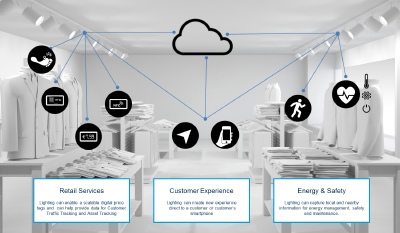Everything gets smarter with IoT

The ‘Internet of Things’ has the potential to deliver far more than lighting data through lighting systems, as Karl Jonsson of Tridonic explains.
Information technology continues to develop apace, moving from the now familiar ‘Internet of screens’ to an even more connected world where everyday devices are able to communicate with each other automatically. This is the so-called ‘Internet of Things’ (IoT).
At the heart of these developments is the trend of including wireless sensor networks in machine-to-machine communication. There is already convergence in the professional building-management industry where lighting, HVAC and other building controls are gradually moving from legacy standards and proprietary implementations to Internet-based standards.
Once connected to a common Internet protocol, lights, sensors and actuators form a smart and connected lighting system and can become a part of the IoT eco-system. In fact, it has been predicted that there will be 50 billion connected devices by 2020.
A major challenge, though, is that all these low-powered devices will have to submit data at a high frequency rate, and do so for many years without being recharged. Clearly an infrastructure is needed to solve this challenge.
Currently, devices are connected via various protocols in separated systems, using multiple wiring layers. The optimal infra-structure would supply a low-power network, be omni-present both indoors and outdoors and provide one standard protocol for the devices to connect with.
I suggest that lighting systems offer the ideal solution. They provide a dense network both inside and outside the building, covering the entire facility. With the growing use of LED lighting, such networks are increasingly digital and connected to a power source.
Moreover, lighting networks already collect useful data, such as occupancy, through luminaires and stand-alone sensors. So far this data is only used for lighting control, but in the next step it can unleash much more value when deployed outside the lighting world. An obvious example is improved visibility of occupancy patterns for use by the building operator in space management.
To make this more tangible in today’s environment, another example could be to use presence sensors from lighting for intrusion detection/alarm systems. Thus, building-services engineers have a great opportunity to use connected lighting to add more value in their designs for the end client.
Connecting lighting to the Internet began in the consumer market, with so-called ‘smart bulbs’ enabling users to manage light levels and colour temperatures to create scenes through hand-held devices.
In the professional market a new generation of connectivity allows lighting to support new features and services that haven't previously been within reach.
For example, as hinted at earlier, using the data collected by occupancy sensors in the lighting control network can also provide useful, real-time information about occupancy patterns. This more meaningful picture can then underpin the organisation’s space management strategy.

Similarly, occupancy sensors in meeting rooms can be interfaced to a room-booking system to indicate when people have arrived. Rooms that are not occupied within a certain time can be made available to others.
Nor is this functionality confined to office space. It can also be used to measure footfall in retail environments, helping retailers to understand the flow of customers more accurately and configure their merchandising accordingly.
Linking to smartphones via a navigation app can help shoppers find products more quickly, while retailers can make them aware of special offers relevant to the area of the shop they are in. Once shoppers reach the correct aisle, they can use the app to summon store staff, who respond quickly, thanks to the tracking functionality via the lighting network.
Deploying such technology will also enable retailers to provide location-based services so that displays, advertising and special offers are more targeted to each shopper’s interests.
Moreover, the technology can be used to improve resource management — with faster stocking of shelves to avoid out-of-stock situations, as well as displaying additional information about products.
In other types of premises, a smart and connected lighting system could underpin a dynamic and context-aware building where settings change dynamically based on a combination of sensory inputs like motion, heat, illuminance, humidity and orientation of objects. IoT sensory data can also contribute to intelligent controls, adjusting shades and window openings.
On the practical side, IoT devices can be connected through wireless and wired protocols such as Ethernet and Wi-Fi. However, because of power requirements and size constraints, they will need to communicate at an alternative wireless layer such as 6LoWPAN to support communication across industries. 6LoWPAN is a wireless, low-power version of the next generation Internet standard IPv6 (today’s internet is still mostly based on IPv4). Several standards bodies, including the Thread Group, are based on 6LoWPAN over IEEE 802.15.4 physical layer.
One of the biggest challenges with IoT has been to simplify setup and installation. Thanks to collaboration between lighting-controls companies, architects, building-services engineers, IT managers and installers there is now real progress towards making Internet-connected lighting a reality that takes lighting way beyond just illumination.
Karl Jonsson is IoT architect with Tridonic, Austria.







